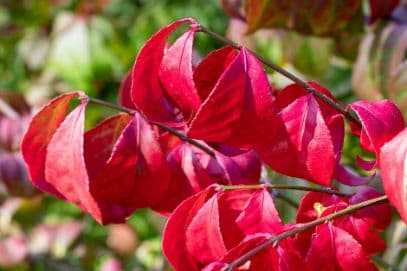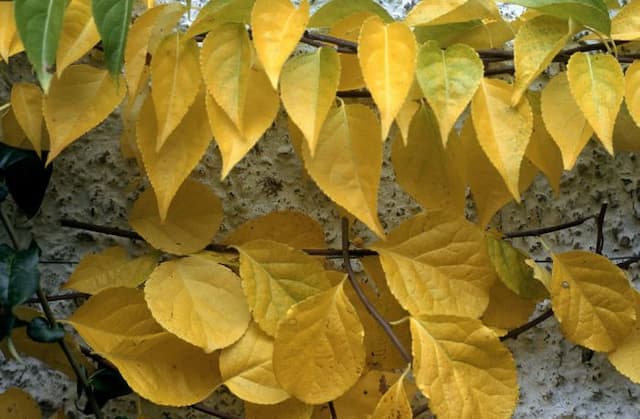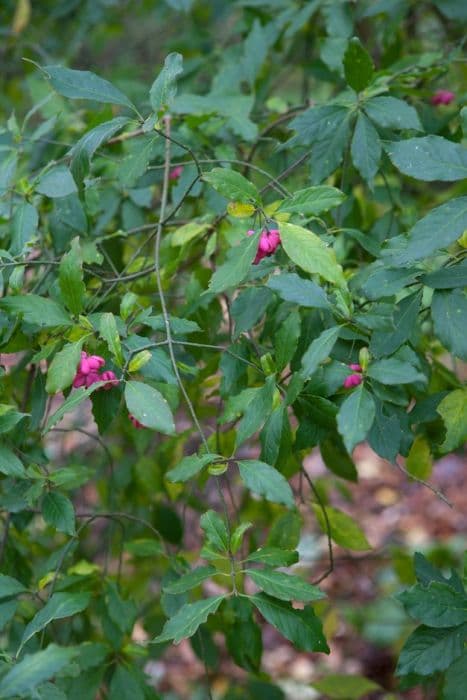Spindle Tree Euonymus europaeus

ABOUT
The plant known as the European spindle is a striking deciduous shrub that has a distinctive appearance through the seasons. It has leaves that are oval-shaped with finely serrated edges and a lush green color that turns to a vibrant red or pink in the fall. This foliage provides a colorful backdrop for the small flowers, which are greenish-yellow and inconspicuous, blooming in clusters during the spring to early summer. One of the most eye-catching features of the plant are the fruits that it produces in the fall. These fruits are small capsules with a bright pink or reddish hue. As they ripen, they split open to reveal seeds covered by a contrasting orange aril, creating a jewel-like effect that is particularly ornamental. The bark of the European spindle is another point of interest, being gray-brown and developing a lightly fissured texture as it matures. The stems are somewhat square in cross-section, and this adds another layer to the plant's architectural interest. Overall, the European spindle has a bushy, compact growth habit and its branches are often slightly pendulous, creating a somewhat weeping effect that adds to its charm, making it a prominent feature in gardens during every season.
About this plant
 Names
NamesFamily
Celastraceae.
Synonyms
European Spindle, European Spindletree, Common Spindle, Spindle Tree, Spindle Bush, Fusoria.
Common names
Euonymus vulgaris, Euonymus angustifolius, Euonymus bullatus, Euonymus carpiniifolius, Euonymus cochleatus, Euonymus lucidus, Euonymus nanus, Euonymus obovatus, Euonymus platyphyllus, Euonymus praecox, Euonymus rarus, Euonymus sanguineus, Euonymus sylvestris, Euonymus tinctorius, Euonymus verrucosus.
 Toxicity
ToxicityTo humans
The common name for Euonymus europaeus is Spindle. It is considered toxic to humans if ingested. The plant, especially the fruits and seeds, contains several toxic compounds, including alkaloids and glycosides. Symptoms of poisoning may include nausea, vomiting, diarrhea, weakness, chills, seizures, and liver failure. Severe poisoning can be life-threatening and requires immediate medical attention.
To pets
Spindle is also toxic to pets. Ingesting parts of this plant can lead to similar symptoms as in humans, such as vomiting, diarrhea, weakness, and incoordination. Pets may also experience changes in heart rate and rhythm. In severe cases, it could lead to liver failure or even death. If you suspect your pet has ingested Spindle, seek veterinary care promptly.
 Characteristics
CharacteristicsLife cycle
Perennials
Foliage type
Deciduous
Color of leaves
Green
Flower color
Greenish-white
Height
10-20 feet [3-6 meters]
Spread
10-20 feet [3-6 meters]
Plant type
Shrub
Hardiness zones
5
Native area
Europe
Benefits
 General Benefits
General Benefits- Landscape Ornamentation: Euonymus europaeus, commonly known as Spindle, offers aesthetic appeal to gardens with its colorful autumn foliage and distinctive pink fruits with orange seeds.
- Habitat for Wildlife: It provides food and shelter for birds and other wildlife, especially during the autumn and winter months when the fruits are ripe.
- Low Maintenance: Spindle is known for being hardy and requiring minimal care once established, making it suitable for low-maintenance landscaping.
- Drought Tolerance: Once established, it is relatively tolerant to drought, reducing the need for frequent watering.
- Windbreak: With its dense growth, Spindle can act as a windbreak or natural screen in landscapes.
- Soil Stabilization: Its root system can help prevent soil erosion in certain landscapes.
- Deciduous Interest: As a deciduous shrub, it provides seasonal interest throughout the year, from spring flowers to autumn fruits and leaf color.
- Insect and Disease Resistance: It has natural resistance to many pests and diseases, lessening the need for chemical treatments.
- Hedging and Topiary: Spindle can be pruned into various shapes, making it suitable for formal hedges and topiary designs.
- Natural Borders: It can be used to define the edges of different areas within a garden or as a property boundary marker.
 Medical Properties
Medical Properties- Cathartic: Euonymus europaeus has been used in traditional medicine as a strong laxative.
- Diuretic: It has properties that promote the increased production of urine.
- Cholagogue: The plant has been used to stimulate the flow of bile into the intestines.
- Anthelmintic: There is some historical use of the plant in treating parasitic worm infections.
- Vermifuge: Similar to its anthelmintic use, it was believed to help expel worms from the body.
 Air-purifying Qualities
Air-purifying QualitiesThis plant is not specifically known for air purifying qualities.
 Other Uses
Other Uses- Spindle wood from Euonymus europaeus is used in traditional crafts for making knitting needles due to its fine-grained, hard texture which makes smooth, durable needles.
- The hard timber of the spindle is ideal for making musical instruments, particularly for detailed parts like pegs and recorders, requiring precise workmanship.
- Fine charcoal can be derived from the dense wood of the spindle plant, which is useful for artists in drawing and sketching.
- The leaves and fruit of the spindle can be used to create yellow and green dyes for textiles, offering an eco-friendly dyeing solution.
- Spindle wood is used in marquetry and cabinetry for inlaying detail into furniture because of its ease of work and fine finish when polished.
- Due to its strength and flexibility, Euonymus europaeus twigs are traditionally used for making small animal traps in bushcraft.
- The wood can be carved into handles for tools and cutlery, proving both functional and aesthetically pleasing with its light hue.
- Spindle branches are used in the rural craft of thatching, where they are made into spars or pegs that hold the thatch in place.
- Euonymus europaeus is sometimes planted in hedgerows and agricultural lands to act as a windbreak and shelterbelt, protecting soil and crops.
- In landscape gardening, the plant's vibrant autumn foliage and distinctive fruits are employed for seasonal ornamental effect.
Interesting Facts
 Feng Shui
Feng ShuiThe European spindle is not used in Feng Shui practice.
 Zodiac Sign Compitability
Zodiac Sign CompitabilityThe European spindle is not used in astrology practice.
 Plant Symbolism
Plant Symbolism- European Spindle (Euonymus europaeus)
- Protection: Historically used to make spindles for wool-spinning, its wood was believed to offer protection, particularly against evil spirits and enchantments.
- Deception: The berries of the European Spindle are bright and alluring but toxic, representing deception and hidden dangers.
- Boundary-setting: The dense nature of the shrub made it ideal for hedges, symbolically representing the establishment of boundaries and privacy.
- Resilience: A hardy plant able to thrive in various conditions, symbolizing adaptability and persistence in the face of adversity.
 Water
WaterThe European Spindle should be watered deeply yet infrequently to mimic natural conditions, typically requiring about 1 inch of water every week during active growth in spring and summer. In the fall, gradually reduce watering to let the plant prepare for winter. Always check the top couple of inches of soil for dryness before watering to ensure the plant actually needs more moisture. Over-watering can lead to root rot, so be cautious not to let the European Spindle sit in waterlogged soil. If you're unsure, it's better to err on the side of too dry rather than too wet.
 Light
LightThe European Spindle thrives best in full sun to partial shade. To ensure it gets the light it needs, plant it in a spot where it can receive at least 4 to 6 hours of direct sunlight a day. However, in regions with very intense sun, a location with afternoon shade can help protect the plant from excessive stress.
 Temperature
TemperatureThe European Spindle is hardy and can tolerate a range of temperatures, from as low as -20°F to as high as 95°F, but it grows best in temperatures between 60°F and 75°F. It can cope with the occasional extremes outside this range, but prolonged exposure to temperatures outside its comfort zone can be harmful.
 Pruning
PruningPrune the European Spindle mainly to maintain shape and remove any diseased or broken branches. The best time for pruning is late winter or early spring before the onset of new growth. It can be pruned annually, but extensive pruning should only be done every few years to prevent stress on the plant.
 Cleaning
CleaningAs needed
 Soil
SoilFor Euonymus europaeus, commonly known as European spindle, the best soil mix is well-draining with a high content of organic matter. A blend of loamy soil, peat, and coarse sand or perlite is ideal. The optimum soil pH for European spindle is neutral to slightly alkaline, ranging from 6.0 to 7.5.
 Repotting
RepottingEuropean spindle trees do not need to be repotted often as they are usually planted outdoors. If grown in containers, young plants may be repotted every 2-3 years to encourage growth. Mature European spindle trees are typically repotted less frequently, only when rootbound.
 Humidity & Misting
Humidity & MistingEuropean spindle, or European spindle tree, generally tolerates a wide range of humidity levels and does not require any specific humidity conditions. It thrives well in the ambient outdoor humidity found in its growing zones.
 Suitable locations
Suitable locationsIndoor
Place in bright, indirect light; water moderately.
Outdoor
Full sun to part shade; shelter from strong winds.
Hardiness zone
4-7 USDA
 Life cycle
Life cycleSpindle (Euonymus europaeus) begins its life cycle with seed germination, which typically occurs in spring after the seeds have undergone a period of stratification to break dormancy. The seedlings develop into juvenile plants with a rapid growth rate, establishing a root system and foliage. As the plant matures, it enters the adult vegetative stage, characterized by the growth of its distinctive green leaves, and the plant continues to increase in size and spread. The reproductive phase starts when the plant is mature enough to produce flowers, often in late spring to early summer, with small, inconspicuous yellow-green blooms that are pollinated by insects. Following pollination, the plant produces its characteristic pink-red fruits known as arils, which mature in autumn and are attractive to birds, aiding in seed dispersal. Finally, the plant enters senescence, where growth slows and it may eventually die; however, Spindle trees can live for many years and continue to produce seeds throughout their lifespan.
 Propogation
PropogationPropogation time
Spring-Early Summer
Propogation: The most popular method of propagating the European spindle (Euonymus europaeus) is by seed. Seed collection should occur in autumn when the fruits have turned a pinkish-red color and opened to reveal seeds covered with a fleshy orange aril. After collection, the seeds need to be cleaned of the fleshy aril and can be sown immediately or stratified. Stratification is a process where seeds are mixed with a moist substrate like sand or peat and kept in a refrigerator at a temperature of 34-41°F (1-5°C) for approximately 90 to 120 days to break dormancy. After stratification, seeds can be sown in containers in spring, barely covered with soil, and kept well-watered. Seedlings usually emerge in one to two weeks, but germination rates can be unpredictable. Once seedlings have grown enough to be handled, they can be transplanted into individual pots or directly into their final position in the garden.







